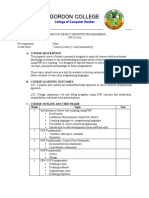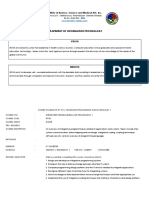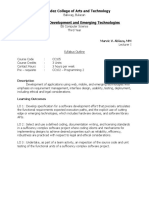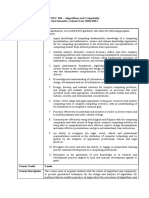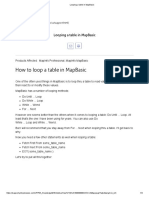0 ratings0% found this document useful (0 votes)
963 viewsProgramming Rubrics
The rubric provides criteria for evaluating computer programs across multiple levels of proficiency. It assesses programs on 7 dimensions: syntax, logic, correctness, completeness, clarity, modularity, and documentation. For each dimension, it describes the characteristics of work that would receive a score of 1 (beginning), 2 (approaching proficiency), 3 (proficient), or 4 (advanced). The rubric can be used to evaluate programming assignments in various computer science courses.
Uploaded by
jive_gumelaCopyright
© © All Rights Reserved
Available Formats
Download as PDF, TXT or read online on Scribd
0 ratings0% found this document useful (0 votes)
963 viewsProgramming Rubrics
The rubric provides criteria for evaluating computer programs across multiple levels of proficiency. It assesses programs on 7 dimensions: syntax, logic, correctness, completeness, clarity, modularity, and documentation. For each dimension, it describes the characteristics of work that would receive a score of 1 (beginning), 2 (approaching proficiency), 3 (proficient), or 4 (advanced). The rubric can be used to evaluate programming assignments in various computer science courses.
Uploaded by
jive_gumelaCopyright
© © All Rights Reserved
Available Formats
Download as PDF, TXT or read online on Scribd
You are on page 1/ 2
Rubric for Computer Programming
Christopher League, November 2013
Can be adapted for assignments to produce software artifacts in CS102, 117, 120, 130, 155, 156, 161, 164, 601, 631, 653, 673, 690, and
others. As stated on AAC&U VALUE rubrics, “evaluators are encouraged to assign a zero to any work…that does not meet beginning (cell
one) level performance.”
Advanced Proficient Approaching Proficiency Beginning
4 3 2 1
Syntax Program compiles and Program compiles and is Program compiles, but Program does not compile
Ability to understand and contains no evidence of free from major syntactic contains errors that signal or (in a dynamic language)
follow the rules of the misunderstanding or misunderstandings, but misunderstanding of contains typographical
programming language. misinterpreting the syntax may contain non-standard syntax – such as the semi- errors leading to undefined
of the language. usage or superfluous colon in if(exp);{} names.
elements.
Logic Program logic is correct, Program logic is mostly Program logic is on the Program contains some
Ability to specify with no known boundary correct, but may contain right track with no infinite conditions that specify the
conditions, control flow, errors, and no redundant an occasional boundary loops, but shows no opposite of what is
and data structures that are or contradictory error or redundant or recognition of required (less than vs.
appropriate for the conditions. contradictory condition. boundary conditions (such greater than), confuse
problem domain. as < vs. <=) Boolean AND/OR
operators, or lead to
infinite loops.
Correctness Program produces correct Program produces correct Program approaches Program does not produce
Ability to code formulae answers or appropriate answers or appropriate correct answers or correct answers or
and algorithms that results for all inputs tested. results for most inputs. appropriate results for appropriate results for
reliably produce correct most inputs, but can most inputs.
answers or appropriate contain miscalculations in
results. some cases.
Advanced Proficient Approaching Proficiency Beginning
4 3 2 1
Completeness Program shows evidence Program shows evidence Program shows some Program shows little
Ability to apply rigorous of excellent case analysis, of case analysis that is evidence of case analysis, recognition of how
case analysis to the and all possible cases are mostly complete, but may but may be missing different cases must be
problem domain. handled appropriately. have missed minor or significant cases or handled differently.
unusual cases. mistaken in how to handle
some cases.
Clarity Program contains Program contains some Program contains some Program contains no
Ability to format and appropriate documentation documentation on major documentation (at least the documentation, or grossly
document code for human for all major functions, functions, variables, or student’s name and misleading indentation.
consumption. variables, or non-trivial non-trivial algorithms. program’s purpose), but
algorithms. Formatting, Indentation and other has occasionally
indentation, and other formatting is appropriate. misleading indentation.
white space aids
readability.
Modularity Program is decomposed Program is decomposed Program is decomposed Program is one big
Ability to decompose a into coherent and reusable into coherent units, but into units of appropriate function or is decomposed
problem into coherent and units, and unnecessary may still contain some size, but they lack in ways that make little
reusable functions, files, repetition has been unnecessary repetition. coherence or reusability. sense.
classes, or objects (as eliminated. Program contains
appropriate for the unnecessary repetition.
programming language
and platform).
You might also like
- Computer Engineering Drafting and Design ModulesNo ratings yetComputer Engineering Drafting and Design Modules188 pages
- Principles of Programming Languages: Eliezer A. AlbaceaNo ratings yetPrinciples of Programming Languages: Eliezer A. Albacea68 pages
- IT 06 - Object Oriented Programming OBE Syllabus100% (1)IT 06 - Object Oriented Programming OBE Syllabus5 pages
- Information Management Concepts and FundamentalsNo ratings yetInformation Management Concepts and Fundamentals57 pages
- Nueva Ecija University of Science and Technology: Sumacab CampusNo ratings yetNueva Ecija University of Science and Technology: Sumacab Campus9 pages
- System Integration and Architecture 2 Module 1100% (5)System Integration and Architecture 2 Module 118 pages
- BIT 2109 Integrative Programming and TechnologiesNo ratings yetBIT 2109 Integrative Programming and Technologies4 pages
- Object-Oriented-Programming With PHP5 SYLLABUSNo ratings yetObject-Oriented-Programming With PHP5 SYLLABUS3 pages
- Describe and Contrast Comprehensively The Different Types of Architectures For Integrating Systems100% (1)Describe and Contrast Comprehensively The Different Types of Architectures For Integrating Systems5 pages
- Application Development and Emergin TechnologiesNo ratings yetApplication Development and Emergin Technologies3 pages
- Integrative Programming Technology - Integrative CodingNo ratings yetIntegrative Programming Technology - Integrative Coding45 pages
- System Integration and Architecture Topic OutlineNo ratings yetSystem Integration and Architecture Topic Outline4 pages
- COIT 403 Course Contents in Integrative Programming Technologies PDFNo ratings yetCOIT 403 Course Contents in Integrative Programming Technologies PDF3 pages
- CSPC 104 - Algorithms and Complexity 2nd Semester, School Year 2020-2021100% (1)CSPC 104 - Algorithms and Complexity 2nd Semester, School Year 2020-20213 pages
- Introduction To Computing: What Is A Computer?No ratings yetIntroduction To Computing: What Is A Computer?11 pages
- System Administration and Maintenance Quiz 1100% (1)System Administration and Maintenance Quiz 11 page
- Application Development and Emerging TechnologiesNo ratings yetApplication Development and Emerging Technologies5 pages
- Computer-Programmimg Java J-SHS Quarter-2 LAS-7 Week-7 FinalNo ratings yetComputer-Programmimg Java J-SHS Quarter-2 LAS-7 Week-7 Final18 pages
- IT 12 Data Communication With Networking OBE Syllabus 1hourNo ratings yetIT 12 Data Communication With Networking OBE Syllabus 1hour8 pages
- Rubrics For Systems Analysis and Design Proposals100% (1)Rubrics For Systems Analysis and Design Proposals2 pages
- Computer Networking Course Syllabus GeneNo ratings yetComputer Networking Course Syllabus Gene4 pages
- Info Assurance Security Syll 2 2022-2023No ratings yetInfo Assurance Security Syll 2 2022-20237 pages
- Grading Rubric For Undergraduate Software Projects100% (1)Grading Rubric For Undergraduate Software Projects2 pages
- INTRODUCTION TO COMPUTING (Based and Taken From CMO 25 S. 2015 Pp. 34-37) CC1No ratings yetINTRODUCTION TO COMPUTING (Based and Taken From CMO 25 S. 2015 Pp. 34-37) CC17 pages
- Introduction To Computing (CSEN1201) Syllabus100% (1)Introduction To Computing (CSEN1201) Syllabus2 pages
- Cpe 411 - Syllabus For Embedded SystemsNo ratings yetCpe 411 - Syllabus For Embedded Systems11 pages
- CNT4603 System Administration and MaintenanceNo ratings yetCNT4603 System Administration and Maintenance3 pages
- Module 3 - Application Development and Emerging TechnologiesNo ratings yetModule 3 - Application Development and Emerging Technologies14 pages
- Course Outline (Data Communication and Networking 1)No ratings yetCourse Outline (Data Communication and Networking 1)3 pages
- COMP 20253 Application Development and Emerging Technologies100% (1)COMP 20253 Application Development and Emerging Technologies97 pages
- Icte 10073 Systems Administration and Maintenance 1100% (2)Icte 10073 Systems Administration and Maintenance 1132 pages
- CE1 Computer Engineering As A DisciplineNo ratings yetCE1 Computer Engineering As A Discipline7 pages
- Week 4 Conceptualization and Operationalization of Emerging TechnologiesNo ratings yetWeek 4 Conceptualization and Operationalization of Emerging Technologies32 pages
- OBTLP - CC 2104 - Applications Development and Emerging TechnologiesNo ratings yetOBTLP - CC 2104 - Applications Development and Emerging Technologies6 pages
- Computer Programming: Quarter 1 Week 1 Module 1No ratings yetComputer Programming: Quarter 1 Week 1 Module 17 pages
- IT-423 System Integration and ArchitectureNo ratings yetIT-423 System Integration and Architecture7 pages
- Second Syllabus IT 202 Integrative Programming and Technologies IPTNo ratings yetSecond Syllabus IT 202 Integrative Programming and Technologies IPT6 pages
- CCS0001L: (Introduction To Computing Laboratory)No ratings yetCCS0001L: (Introduction To Computing Laboratory)6 pages
- Object-Oriented Programming - 1 Sem SY 2021-2022 Activity 2: Applying Control Structures Competencies MeasuredNo ratings yetObject-Oriented Programming - 1 Sem SY 2021-2022 Activity 2: Applying Control Structures Competencies Measured2 pages
- Horatio - Wjec A2 Computing Unit 3 4 3 5No ratings yetHoratio - Wjec A2 Computing Unit 3 4 3 53 pages
- Petition: Regional Trial Court 11 Judicial Region Branch 2No ratings yetPetition: Regional Trial Court 11 Judicial Region Branch 22 pages
- St. Thomas More School of Law and Business Doctolero Avenue, Tagum City Davao Del NorteNo ratings yetSt. Thomas More School of Law and Business Doctolero Avenue, Tagum City Davao Del Norte1 page
- Request For Quotation: Linao National High SchoolNo ratings yetRequest For Quotation: Linao National High School3 pages
- Circuit Overseer's Visit Territory: (June 5-10, 2018)No ratings yetCircuit Overseer's Visit Territory: (June 5-10, 2018)2 pages
- People of The Philippines vs. Edgardo Dimaano: FactsNo ratings yetPeople of The Philippines vs. Edgardo Dimaano: Facts6 pages
- Message Queues, Mailboxes, and Pipes - RTOS100% (2)Message Queues, Mailboxes, and Pipes - RTOS4 pages
- Program - 3: AIM: Write A C Program To Implement Cyclic Redundant CheckNo ratings yetProgram - 3: AIM: Write A C Program To Implement Cyclic Redundant Check4 pages
- BSS Implementation: Technical DescriptionNo ratings yetBSS Implementation: Technical Description926 pages
- Transportation Problem: Finding Initial Basic Feasible Solution - Reena RajNo ratings yetTransportation Problem: Finding Initial Basic Feasible Solution - Reena Raj20 pages
- Write a Code to Ask the User for Two Numbers - Google SearchNo ratings yetWrite a Code to Ask the User for Two Numbers - Google Search1 page
- Embedded Sat Ate Machines ImplementationNo ratings yetEmbedded Sat Ate Machines Implementation11 pages
- Top 60 C++ Interview Questions and Answers For 2022No ratings yetTop 60 C++ Interview Questions and Answers For 202228 pages
- Module 5. Computer Security AND Case Study of Linux OsNo ratings yetModule 5. Computer Security AND Case Study of Linux Os8 pages
- BCT 2311 Compiler Construction Course OutlineNo ratings yetBCT 2311 Compiler Construction Course Outline2 pages
- Command Line Arguments in Java TutorialNo ratings yetCommand Line Arguments in Java Tutorial16 pages
- Example 5: Demo Program Example 5: Program Source CodeNo ratings yetExample 5: Demo Program Example 5: Program Source Code5 pages
- Method of Assessment: Internal: Mid Semester Theory Examination (Pen Paper Test)No ratings yetMethod of Assessment: Internal: Mid Semester Theory Examination (Pen Paper Test)22 pages














